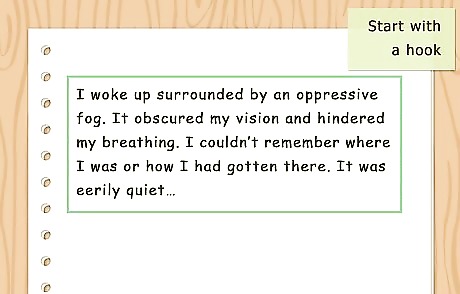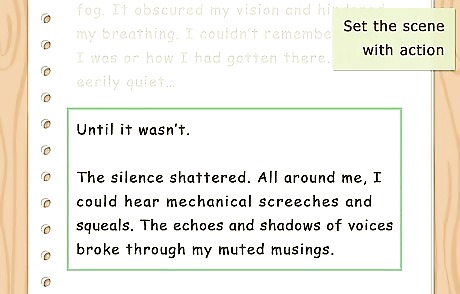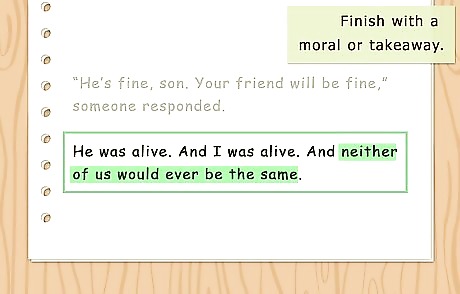
views
- Center your narrative around an important moment in your life. For example, you might write about a time you had to make a hard decision or deal with a conflict.
- Move chronologically through the events you’re discussing. This will make your narrative easy to follow and draw your reader in.
- Finish with a moral takeaway or a life lesson. What did you learn from these events, and why is it important? How did they shape you as a person?
Brainstorming Ideas for the Narrative

Focus on a memorable event or moment in your life. The personal narrative should focus on a specific event or moment that was memorable or made a big impression on you. It does not need to be a major moment as long as it feels memorable and important to you. The event could have seemed minor at the time but ended up being life changing for you. For example, you may write about your struggles with body image in high school and how you overcame them in adulthood. Or you may write about your disastrous 15th birthday party and how it affected your relationship with your mother.

Expand on an important conflict in your life. Personal conflict can be great fodder for a personal narrative. Think about any strained relationships in your life or any moments of major conflict that you have experienced. Explore the conflict in detail in the narrative. For example, you write a personal narrative about your complicated relationship with your birth mother. Or you may write about a conflict you have with a sport you play or a club you are a part of.

Think about a particular theme or idea. Use a theme as a jumping off point for the narrative. Explore a theme or idea from your perspective. Consider how the theme applies to your life and your experiences thus far. Themes like poverty, isolation, sacrifice, and talent are all good options for a personal narrative. For example, you may explore a theme like poverty by writing about your family’s struggle with money and finances. You may write about having to defer college applications to work at your parent’s business to make ends meet for your family.

Read examples of personal narrative. Learn from good examples of the genre online and in print. Search for the top personal narratives online to see what a successful narrative looks like. Read and learn from these examples. You may read: The Boys of My Youth by Jo Ann Beard Slouching Towards Bethlehem by Joan Didion Me Talk Pretty One Day by David Sedaris The Lives section of The New York Times
Writing the Personal Narrative

Start with a hook. Begin the personal narrative by drawing the reader in with a strong opening sentence. Use rich description and detail in the opening. Start in action so the reader is grabbed right away and keeps reading. For example, the first line in the personal narrative by Tony Gervino is attention grabbing: “I was 6 when my brother John leaned across the kitchen table and casually whispered that he had killed Santa Claus.”

Set the scene with action. Ground the reader in the story by providing information on the main characters and the central conflict or theme. Tell the reader where the narrative is taking place and when it is taking place. Explain whether the story is about you and/or you and your relationship with someone else in your life. For example, in Tony Gervino’s essay, he sets the scene by providing setting, character, and narrative voice: “It was July 1973, we were living in Scarsdale, N.Y., and he was four years older than I was, although that seemed like decades.”

Move chronologically through the events. Do not jump to different moments in time or move from a past event to a present event and then back again in the same paragraph. Go chronologically from event to event or moment to moment. This will make it easier for the reader to follow along with the narrative. For example, you may start with an event in childhood with your older sister and then move forward in time to the present day, focusing on you and your older sister as adults.

Use sensory detail and description. Focus on how things smelled, sounded, tasted, felt, and looked in the scene. Paint a vivid picture for the reader so they feel immersed in the narrative. Try to describe moments in the narrative based on the speaker’s perspective. For example, you may describe the feeling of your mother’s famous lemon cake as “rich and zesty, with a special ingredient that to this day, I cannot identify.”

Finish with a moral or takeaway. Most personal narratives end with a reflection or analysis of the events. You may come up with a moral that you share with the reader based on your own experiences. Or you may leave the reader with a takeaway thought that illustrates what you learned from your experiences. For example, you may end a personal narrative about your complicated relationship with your troubled sister by ending on a recent memory where you both enjoyed each other’s company. You may leave the reader with a lesson you have learned about loving someone, even with all their messiness and baggage.
Polishing the Personal Narrative

Read the narrative out loud. Once you have finished a draft of the personal narrative, read it aloud to yourself. Listen to how the narrative sounds out loud. Notice if there are any awkward moments or unclear sentences. Circle or underline them so you can revise them later. You can also try reading the narrative out loud to someone else so they can hear how it sounds. This can then make it easier for them to give you feedback.

Show the narrative to others. Ask a friend, peer, classmate, or family member to read the narrative. Pose questions to them about the style, tone, and flow of the narrative. Ask them if the narrative feels personal, detailed, and engaging. Be willing to accept feedback from others. Be open to constructive criticism as it will likely strengthen the narrative.

Revise the narrative for clarity and length. Read over the narrative for any spelling, grammar, or punctuation errors. Review the narrative to make sure it is not too long, as personal narratives are usually short, no more than one to five pages long. You may also need to meet a specific length requirement if you are writing the personal narrative for a class.




















Comments
0 comment